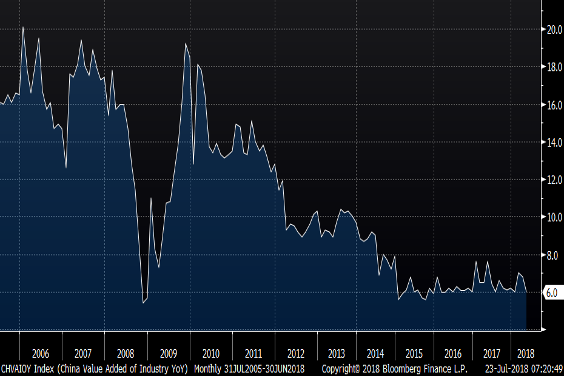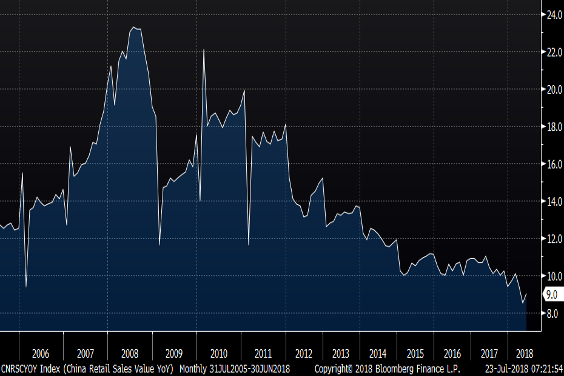by Doug Kass, Seabreeze Partners Management
- Economic growth is less synchronized than the consensus believes
- On a trending and rate of change basis the economic data is slowing down
- The Fed’s continued pivot to tighter money will likely lead to curve inversion – which will likely stoke fears of recession
“China, Europe and the Emerging Market Economic Data All Signal Slowdown: It’s in the early innings of such a slowdown based on any realtime analysis of the economic data. The rate of change slowdown (on a trending basis) is as clear as day. A rising US Dollar and weakening emerging market economic growth sows the seeds of a possible US dollar funding crisis.” – Kass Diary, Investors are Not Being Compensated For Risk
At economic peaks everything on the surface looks Rosy (except to some observors like myself and Rosie (David Rosenberg)!) – until it doesn’t.
Towards that end, here is what I wrote yesterday about US and overseas economic growth in my two part opener:
“Global Growth Is Less Synchronized as the trajectory of worldwide growth is becoming more ambiguous. I have featured the erosion in soft and hard high frequency data in the US, Europe, China and elsewhere extensively in my Diary – so I wont clutter this missive with too many charts. But needless to say (and seen by these charts and here), with economic surprises moderating from a year ago and in the case of Europe falling to two year lows – we are likely at ‘Peak Global Growth’ now. (The data is even worse in South Korea, Taiwan, Indonesia and Thailand).
Indeed there is now ample evidence that 2Q2018 will also represent ‘Peak US Growth’ – as a number of trade related benefits goose the soon to be released second quarter GDP. (Note: Second quarter inventory accumulation was 4x compared to the average over 4Q2017 and 1Q2018, as companies try to secure lower cost product along the supply chain).
This cautionary view of trade tensions threatening global economic growth was confirmed in the G20 statement over the weekend:
‘Global growth remains robust and many emerging-market countries are better prepared to face crises, but risks to the world economy have increased, finance ministers and central bankers from the Group of 20 nations said in a statement published at the end of their two-day summit in Buenos Aires… The main risks are “rising financial vulnerabilities, heightened trade and geopolitical tensions, global imbalances, inequality and structurally weak growth,” the statement read. Emerging markets also face threats including market volatility and capital outflows, according to the G-20. The group’s March statement didn’t mention trade tensions.’
Both housing and autos are likely peaking, and the resetting of rates (higher) will further diminish growth prospects and provide a burden and headwind for those in the private and public sector that are stuck with variable rate debt. (Remember the debt bubble matters not until the rate rise accelerates – which is already occurring on the short end of the curve).
Meanwhile, despite protestations from the Administration, there is no evidence that the reduction in tax rates will trickle down – it’s likely to continue to trickle up to those individuals that possess large balance sheets consisting mostly of real estate and equities. This will have market and social ramifications.
Some charts in support of this view follows.
The Citigroup US Economic Surprise Index has fallen to zero (Europe is negative):
Source: Peter Boockvar
Chinese industrial production growth (year over year) is stagnating:
Source: Peter Boockvar
Chinese retail sales are dropping (year over year):
Source: Peter Boockvar
Bottom Line
” A pivot in monetary policy, a further rise in the risk free rate of return, policy and profit uncertainty and a softening in soft and hard high frequency economic data are some of the reasons that point to a lower and destabilized stock market” – Kass Diary, Investors Are Not Being Compensated For Risk
If I am correct in my forecasts of a continued Fed pivot to tightening and of emerging weakness in economic growth, history indicates a yield curve inversion lies ahead and the US will be in a recession somewhere between July, 2019 and the summer of 2020.
And, in all likelihood, stocks will begin to discount these developments (as fears of a recession are stoked) during the second half of this year.”
Tops Are Processes And We May Be In That Process
- The search of value and comparing it to risk taken is, at its core, the marriage of a contrarian streak and a calculator
- Investors are no longer being compensated for taking risk as the market’s margin of safety has shrunk to microscopic levels
- Last week I liquidated my equity longs and I remain net short in exposure
“Tops are a process, bottoms are an event.” –Wall Street adage
Tops are a process and bottoms are an event, at least most of the time in the stock market. If you looked at an ice cream cone’s profile, the top is generally rounded and the bottom V-shaped. That is how tops and bottoms often look in the stock market, and I believe that the market is forming such a top now.
- Downside Risk Dwarfs Upside Reward. I base my expected market view on the probabilities associated with five separate (from pessimistic to optimistic) projected outcomes that seize on a forecast of economic and corporate profit growth, inflation, interest rates and valuation.
- Global Growth Is Less Synchronized . The trajectory of worldwide growth is becoming more ambiguous. I have chronicled extensively the erosion in soft and hard high-frequency data in the U.S., Europe, China and elsewhere, so I won’t clutter this missive with too many charts. But needless to say (and as shown by these charts here and here), with economic surprises moderating from a year ago and in the case of Europe falling to two-year lows, we are likely at “Peak Global Growth” now. (The data are even worse in South Korea, Taiwan, Indonesia and Thailand.)
- FAANG’s Dominance Represents an Ever-Present Risk. Last Monday I warned that earnings disappointments in the FANG stocks represents an immediate risk to this league-leading sector, and to the markets FANG has become GA!
- Market Structure Is One-Sided and Worrisome. Machines and algos rule the day; they, too, are momentum-based on the same side of the boat. The reality that “buyers live higher and sellers live lower” represents the potentially dangerous condition that investors face in a market dominated by passive investors.
- Higher Interest Rates Not Only Produce a More Attractive Risk-Free Rate of Return, They Also Make It Hard for the Private and Public Sectors to Service Debt
- Trade Tensions With China Are Intensifying and Mr. Market Is Improperly Looking Past Marginal Risks. From Goldman Sachs’ David Kostin (h/t Zero Hedge). Remember, as discussed within this column, the dispute has buoyed second-quarter U.S. GDP. The “benefit” soon will be over and a second-quarter economic cliff is possible.
- Any Semblance of Fiscal Responsibility Has Been Thrown Out the Window by Both Political Parties. This has very adverse ramifications (which shortly may be discounted in lower stock prices), especially as it relates to the servicing of debt — a subject I have written about often. Not only are our legislators acting irresponsibly and recklessly, but the Republican Party is now considering more permanent tax cuts. Should economic growth moderate, tax receipts diminish and undisciplined spending continue, stock valuations will likely continue to contract.
- Peak Buybacks. Buybacks continue apace, but look who’s selling. As Grandma Koufax used to say, “Dougie, that’s quite a racket!” If I am correct about the peaking in corporate profits, higher interest rates and slowing economic growth, we shortly will have another rate of change — negative in buybacks.
- China, Europe and the Emerging Market Economic Data All Signal a Slowdown. It’s in the early innings of such a slowdown based on any real-time analysis of the economic data. The rate-of-change slowdown on a trending basis is as clear as day. A rising U.S. dollar and weakening emerging-market economic growth sow the seeds of a possible U.S. dollar funding crisis.
- The Orange Swan Has Returned. Again, hastily crafted policy delivered by Twitter that conflates politics is dangerous in a flat and networked world. The return of an untethered Orange Swan is market-unfriendly… brace yourselves as the Supreme Tweeter will likely “Make Economic Uncertainty and Market Volatility Great Again” (#MUVGA)
- We Are Moving Closer to the November Elections, With Their Uncertainty of Outcome and the Potential For a “Blue Wave.” The current 40% approval rating for the president is historically a losing proposition for the incumbents. We also may be moving toward some conclusion of the Mueller investigation — is the Summer of 2018 the Summer of 1974?
Bottom Line
“Confronted with a challenge to distill the secret of sound investment into three words, we venture the motto, Margin of Safety.” –Benjamin Graham
The search for value and comparing it to risk taken is, at its core, the marriage of a contrarian streak and a calculator.
While it is important to gauge the possibility that the market may be making an important top, it is even more important to distill, based on reasonable fundamental input, what the market’s reward vs. risk is. This calculus trumps everything else that I do in determining market value.
On that front, I continue to believe that downside risk dwarfs upside reward.
Moreover, there is a growing fundamental and technical list of signposts that may suggest that the market is starting to look like it is in the process of making a possible (and important) top.
As Joel Greenblatt wrote:
“There’s a virtuous cycle when people have to defend challenges to their ideas. Any gaps in thinking or analysis become clear pretty quickly when smart people ask good, logical questions. You can’t be a good value investor without being an independent thinker – you’re seeing valuations that the market is not appreciating. But it’s critical that you understand why the market isn’t seeing the value you do. The back and forth that goes on in the investment process helps you get at that.”
And, I do a lot of back and forth every day in my Diary!



















